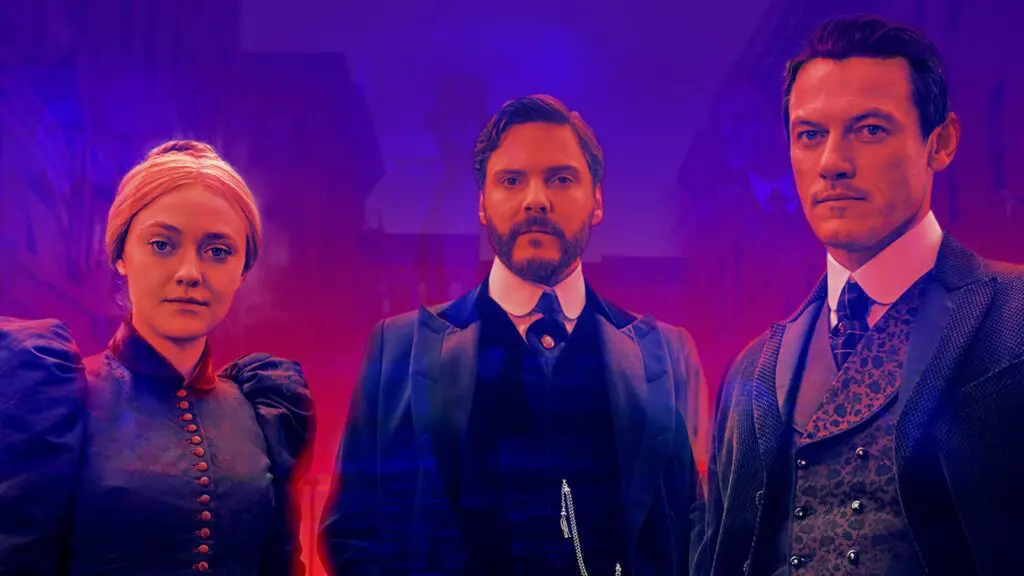Summary
Not everyone ends up where they want to be in the final two episodes of The Alienist: Angel of Darkness, but all are changed by the experience as the season comes to a solid close.
This recap of The Alienist Season 2 (Angel of Darkness) Episode 7, “Last Exit to Brooklyn”, and Episode 8, “Better Angels”, contains spoilers. You can check out our thoughts on the last two episodes by clicking these words.
Noble aims aren’t always pursued by noble methods, or at least that’s what The Alienist: Angel of Darkness episode 7 attempts to argue in its opening, which juxtaposes two very different forms of detective work. All parties are on the hunt for Libby Hatch and the Vanderbilt child she has kidnapped and is obsessively breastfeeding as her own, but while John and Sara look into Libby’s father’s suicide with the Brooklyn police, Burns rams Fat Jack’s face into a bar and offers his boss, Goo Goo Knox, a hefty sum of money for the safe return of the child.
As it turns out, Libby comes from a good family of means — a term repeated again and again throughout “Last Exit to Brooklyn” as an excuse or an explanation for a whole host of different things, as class tends to confer those kinds of privileges. She was also institutionalized for two years for trying to murder her mother, so you know — money isn’t everything.
This is all part of Libby’s bizarre pathology, which Laszlo attempts to determine by accompanying Karen to an “alternative club”, where the black hermaphrodite proprietor, Alice, discusses with him how her partner has a fixation identical to that of Libby — a detachment and fervent need for connection rooted in abandonment. Laszlo and Karen work through the profiling together, and one can’t help but wish she had been introduced earlier and they’d had more to do as a pair.
That profile is quickly proved very accurate, though, as The Alienist: Angel of Darkness episode 7 cuts to Libby feeding the babe in front of a rather fake-looking window, promising Goo Goo that she’ll save him some. Presumably pleased with his no doubt healthy bones and teeth, Goo Goo meets with Fat Jack, who informs him of Burns’s offer of payment for the child’s release.
John and Sara are struggling to work with Burns in “Last Exit to Brooklyn” since he’s the kind of guy who callously tosses coins to street urchins. John, as a reminder to the audience that they slept together last week, mentions to Sara that they have some things to discuss, but now isn’t exactly the time. Instead, along with Laszlo and Burns, they visit Libby’s mother, Mallory Hunter, who has been expecting them after reading about the case in the papers. She relays the family’s posh background, the husband’s unexpected suicide — Laszlo theorizes that, being from the country, he might have found the lifestyle ill-fitting — and the story of Libby’s biological child being taken away on the grounds that she was unable to care for her. Laszlo, though, sees right through this and lays out pretty bluntly that Mallory herself fabricated the attempted murder story in order to justify the child being taken away (this is where that whole “family of means” thing comes up again, validating a need to prove Libby was incapable of caring for her child since removing her from the care of a well-to-do family would have been the last resort.) Mallory still has the papers from the orphanage, and the new working suspicion is that Libby has come back to retrieve her daughter.
When Goo Goo tells Libby about Burns’s offer, and cautions her about the Pinkertons, she flat-out refuses to play ball and he’s forced to take the Vanderbilt child for himself, which he claims he’s doing for her. Meanwhile, the Isaacsons arrive with the memory boxes Libby created to memorialize her victims, the oldest of which is for her own daughter.
Goo Goo, despite having taken the child, nonetheless skips the rendezvous with Burns, watching on as Fat Jack takes a licking as a message for him. With no success, Burns proposes to Hearst using Libby’s child to lure her out, and he takes this proposition to Mallory under the guise of an offer from Cornelius Vanderbilt himself. With Mallory’s help, he gets Libby’s daughter, Clara, to pose for photos that make the papers, and that are soon seen by Libby and Sara, the latter of whom takes the matter to John, who takes it to Hearst. Hearst, as is typical, speaks only in vague terms about how he doesn’t want to see Violet hurt and how John surely knows what he must do in regard to his public relationship with Sara.
Sara and Laszlo arrive at Mallory’s home, fuming at what Burns has done, with the intention of taking Clara away to safety. But Libby is apparently inbound, though she’s smart enough to send a decoy with a delivery and a message — a single bullet, with the promise that she has one for each of them. This flushes everyone out of the building, as Libby and Goo Goo watch from afar. Libby, though, catches a glimpse of Clara, which leads to their being spotted and having to flee. Libby is eventually cornered by a police captain who dopily turns his back on her. She slashes his throat, steals his gun, and blends back into the busy Brooklyn street.
The Alienist: Angel of Darkness episode 7 finally has Sara and John reckon with their feelings for one another; he even stands up Hearst and Violet at a swanky dinner in order to do so, and they’re forced to order for him in his absence, both competing over who knows his tastes better. Over the phone, Sara tells him that she enjoyed what happened between them but that they didn’t think it through. When he asks what she wants she’s unable to answer, and so he makes a decision for both of them, hanging up the phone and leaving as we see his phone continue to ring as Sara calls back, having presumably made her mind up.
But Sara is interrupted by Libby, who holds her at gunpoint and demands to know where Clara is. Sara offers to reveal this info if she’ll give up the Vanderbilt baby. It’s a tense negotiation which takes a predictably sour turn, but John arrives in the nick of time. Libby, though, is able to overpower him — typical of a journalist, really, especially a posh one — and hold a knife to his throat. Sara points a gun at Libby, who tells her to put it down or John dies, which is where “Last Exit to Brooklyn” ends.

The Alienist: Angel of Darkness episode 8, the finale, picks right up from there, with Sara telling Libby that she’ll reveal where Clara is if she puts the knife down. But Libby, perhaps something of an alienist herself, quickly deduces their relationship and realizes that Sara will give up the info in exchange for John’s life. As she starts to cut his throat, Sara blurts out that Clara is at the Kreizler Institute, but John takes the momentary distraction to disarm Libby, who won’t say where the Vanderbilt baby is.
Having now faced losing each other, Sara and John lay out their true feelings in “Better Angels”. She’s not sure she can provide the life and the family she knows he wants. He needs rest, but he insists on coming along to protect Clara. We’re really dragging this relationship out, aren’t we?
Burns, meanwhile, “interviews” Libby, bragging about the first, second, and third degrees of Burns, right before he dunks her head in a bucket of water. The subjects of his interrogations always break, he claims, but he’s barking up the wrong tree here.
Some meanwhiles in The Alienist: Angel of Darkness episode 8. Firstly, Stratton has an invitation from Sigmund Freud himself to go to Vienna, and while she invites Laszlo along, he elects to stay put. We also see that Goo Goo and his men have the Vanderbilt kid, though he’s debating leaving “it” since he doesn’t know if Libby wants “it”, and am I the only person who gets really uncomfortable when someone callously describes a kid as an “it”? I suppose that’s the point. Anyway, Libby bites one of her torturers’ ears off, and Laszlo has to tell Burns in the manner of a child that he’s wasting his time trying to break someone who is already broken. Oh, and the Isaacsons are babysitting Clara, which will become very important a bit later on in “Better Angels”.
Laszlo recommends Sara conduct the interview with Libby since he has no time to get to know her and she’ll distrust an unfamiliar face, especially now after being tortured. Sara agrees, and Libby tells her how her mother faked the attempted murder — which we already knew. But Sara responds by saying that she believes some women shouldn’t have children and only do so because they believe it’s expected of them, which speaks to the inherent sexism of the time. She also claims her mother was one of these women, much like Libby’s. Her mother didn’t love her, but her father did — again, much like Libby’s. This, at least, they have in common. Sara offers to bring Clara to Libby if she tells her where the Vanderbilt baby is, and she does, but as Sara is leaving Libby asks when she can see Clara and the detective closes the door without a word. It’s a cruel move that she frets about immediately afterward while Burns, his men, and Moore head out to retrieve the child.
They’re able to, but it’s a diversion so that Goo Goo and the Hudson Dusters can attack the police station, where Laszlo and Sara lock themselves in a cell and Goo Goo is able to free Libby, leaving behind carnage in his wake. Libby and Goo Goo immediately visit the Isaacsons, who confront them. Goo Goo knocks out Lucius and shoots Marcus, which is a pretty major moment, and Libby finds Clara. In a touching scene, Lucius comes to after they’ve left and begs his brother not to leave him. In a subsequent scene, everyone pays their respects to the fallen Marcus, and John takes the opportunity to tell Sara how he resents his inherited gentleman status. Surely this isn’t the right time?
Sara, John, Laszlo, and Bitsy go over all the information collected during the case and deduce, rather quickly if you ask me, that Libby, having reunited her family unit, is returning to the halcyon days of her childhood. She’s going home.
They hook up with Burns and his men, then, for the final sting of The Alienist: Angel of Darkness episode 8. Wary of a possible trap, Sara, Laszlo and John enter the residence anyway — it’s so opulent that Goo Goo doesn’t believe she ever lived there — and creep through. Goo Goo is able to get the drop on them, but Lucius shoots him dead from behind, a nice little moment of payback for a distinctly unsavory character. All the breastmilk in the world can’t protect him from that. The show’s enduring threesome confronts Libby, now suddenly alone, and holding a broken bottle to Clara’s neck. Laszlo, finally doing something worthwhile this season, assures Libby that what happened to her won’t determine her daughter’s fate, and she lets the girl go, breaking down in tears as Burns takes her away.
In an epilogue, “Better Angels” reveals that John has been promoted, but also that Violet is pregnant, which kind of puts paid to his fling with Sara since a child is what he has always wanted — something that Sara knows. He explains how he hopes to see something of his brother in his own child, and Sara says she hopes so too as they tearfully embrace. It’s almost as if their getting together was a waste of time and a minor betrayal of their characters, but not to worry so late in the game.
To close off Laszlo’s arc, he speaks with Cyrus about purpose, about having become somewhat disillusioned with the Institute, trapped by it and hidden behind its walls. “Sometimes Laszlo,” goes the sage advice, “you have to decide what it is you want and then fight for it.” Laszlo takes this on board, deciding to go to Vienna with Karen. He, John, and Sara enjoy one last dinner until they all go about their suddenly separate lives. Until another season, one supposes.
But this one really couldn’t end without properly crystalizing its underlying theme and paying off its renewed focus on Sara, so The Alienist: Angel of Darkness episode 8 closes with two scenes focusing on her. In the first, she visits Libby in prison, reminiscing about their conversations and looking at her through her cell door, but she leaves without speaking to her. In the second, she introduces her new hire, Kitty, to the detective agency and gives an inspiring speech about equality. Hey, look, we’re not giving out points for subtlety here. The camera leaves through the window and takes in the busy New York street. There is plenty of work to be done.



